top of page

Reptiles and Amphibians
Bang Kachao hosts a diverse range of reptiles and amphibians. Monitor lizards bask in the sun along its waterways, while snakes like the reticulated python and the large-eyed pit viper slither through the undergrowth. Frogs and toads, including the Common asian toad, add to the area's rich tapestry of amphibian life.
Click on a photo to learn more about the animal.
Reptiles

งูสามเหลี่ยม
งูสามเหลี่ยมลาย (Bungarus fasciatus) เป็นงูที่มีพิษร้ายแรงซึ่งพบได้น้อยมากในพื้นที่กรุงเทพฯ โดยพบได้ในภูมิภาคต่างๆ ทั่วเอเชีย ตั้งแต่อนุทวีปอินเดีย เอเชียตะวันออกเฉียงใต้ ไปจนถึงจีนตอนใต้ งูสามเหลี่ยมชนิดนี้เป็นงูที่ยาวที่สุดในสกุล โดยมีความยาวมากกว่า 2 เมตร (6 ฟุต 7 นิ้ว) และมีลักษณะเด่นคือมีแถบสีดำและสีเหลืองสลับกันไปรอบลำตัว งูสามเหลี่ยมลายนี้แม้จะเชื่อง แต่พิษของงูสามเหลี่ยมลายนี้เป็นพิษต่อระบบประสาทอย่างรุนแรงและเป็นอันตรายถึงชีวิตต่อมนุษย์ แม้ว่าพิษของงูสามเหลี่ยมลายนี้จะมีความเป็นพิษน้อยกว่างูสามเหลี่ยมสายพันธุ์อื่นๆ ตามผลการศึกษา LD50 แต่ขนาดที่ใหญ่กว่าทำให้มีพิษมากกว่า ลักษณะเด่น ได้แก่ หัวที่กว้างและแบนซึ่งกลืนไปกับคอ ตาสีดำ และลายสีเหลืองที่โดดเด่นบนหัวซึ่งโดยปกติแล้วจะเป็นสีดำ โดยมีริมฝีปาก คาง คอ และหางขนาดเล็กซึ่งมีความยาวประมาณหนึ่งในสิบของความยาวลำตัว บุคคลที่มีความยาวที่สุดที่ได้รับการบันทึกไว้คือ 2.25 เมตร (7 ฟุต 5 นิ้ว) แม้ว่าโดยทั่วไปจะพบว่ามีความยาวประมาณ 1.8 เมตร (5 ฟุต 11 นิ้ว)

จิ้งจกสวนตะวันออก
กิ้งก่าสวนตะวันออก (Calotes versicolor) หรือที่รู้จักกันในชื่อกิ้งก่าสวนตะวันออก กิ้งก่าสวนอินเดีย หรือกิ้งก่าที่เปลี่ยนรูปร่างได้ เป็นกิ้งก่าในกลุ่มอะกามิดที่พบได้ทั่วไปในอินโด-มาลายาและนำเข้าไปยังภูมิภาคอื่นๆ
กิ้งก่าชนิดนี้เป็นสัตว์กินแมลง โดยตัวผู้จะมีคอสีแดงสดเมื่อผสมพันธุ์ ลำตัวมีความยาวมากกว่า 10 ซม. และยาวได้ถึง 37 ซม. เมื่อรวมหางเข้าไปด้วย สีจะแตกต่างกันไปตั้งแต่สีน้ำตาลสม่ำเสมอไปจนถึงสีเหลือง ตัวผู้จะมีหัวและไหล่สีส้มสดจนถึงสีแดงเข้มเมื่อผสมพันธุ์ โดยมีคอสีดำ กิ้งก่าทั้งสองเพศมีหงอนตั้งแต่หัวจรดหาง จึงได้รับชื่อว่า "กิ้งก่าต้นไม้หงอน"
กิ้งก่าชนิดนี้เป็นสัตว์กินแมลง โดยตัวผู้จะมีคอสีแดงสดเมื่อผสมพันธุ์ ลำตัวมีความยาวมากกว่า 10 ซม. และยาวได้ถึง 37 ซม. เมื่อรวมหางเข้าไปด้วย สีจะแตกต่างกันไปตั้งแต่สีน้ำตาลสม่ำเสมอไปจนถึงสีเหลือง ตัวผู้จะมีหัวและไหล่สีส้มสดจนถึงสีแดงเข้มเมื่อผสมพันธุ์ โดยมีคอสีดำ กิ้งก่าทั้งสองเพศมีหงอนตั้งแต่หัวจรดหาง จึงได้รับชื่อว่า "กิ้งก่าต้นไม้หงอน"

งูแสงอาทิตย์
Xenopeltis unicolor หรือที่เรียกกันทั่วไปว่างูแสงอาทิตย์หรืองูเหลือมสีรุ้ง เป็นงูไม่มีพิษซึ่งมีถิ่นกำเนิดในเอเชียตะวันออกเฉียงใต้และบางส่วนของอินโดนีเซีย งูชนิดนี้มีเกล็ดสีรุ้งที่สวยงาม พวกมันเป็นงูที่ออกลูกเป็นไข่ โดยวางไข่ได้ครั้งละ 10 ฟอง งูชนิดนี้อาศัยอยู่ในพื้นที่โล่ง เช่น ป่าที่โล่ง สวน สวนสาธารณะ และนาข้าว
เมื่อเป็นงูที่รัดเหยื่อ พวกมันจะปราบเหยื่อโดยการหายใจไม่ออก งูแสงอาทิตย์เป็นงูที่หากินตามโพรงไม้เป็นหลัก และใช้เวลาส่วนใหญ่อยู่ใต้ดิน
เมื่อเป็นงูที่รัดเหยื่อ พวกมันจะปราบเหยื่อโดยการหายใจไม่ออก งูแสงอาทิตย์เป็นงูที่หากินตามโพรงไม้เป็นหลัก และใช้เวลาส่วนใหญ่อยู่ใต้ดิน

เต่ากินหอยทากมาเลย์
เต่ากินหอยทากมาเลย์ (Malayemys macrocephala) เป็นสายพันธุ์ในสกุล Malayemys ของวงศ์ Geoemydidae เต่าชนิดนี้มีถิ่นกำเนิดในกัมพูชา เมียนมาร์ มาเลเซียตะวันตก และไทย
มีกระดองยาวได้ถึง 30 ซม. มีสันนูนหรือ "กระดูกงู" 3 สันที่ชัดเจนที่ด้านบน ขณะที่ขอบและด้านล่างเป็นสีเหลือง หัวเป็นสีดำมีเส้นสีขาวหรือเหลืองโค้งไปรอบๆ ดวงตา เต่าชนิดนี้มักพบในแหล่งน้ำที่ไหลช้า มีพื้นเป็นโคลนและมีพืชพรรณมากมาย เช่น หนองบึง หนองบึง นาข้าว และคลองชลประทาน โดยกินหอยทากเป็นอาหารหลัก
มีกระดองยาวได้ถึง 30 ซม. มีสันนูนหรือ "กระดูกงู" 3 สันที่ชัดเจนที่ด้านบน ขณะที่ขอบและด้านล่างเป็นสีเหลือง หัวเป็นสีดำมีเส้นสีขาวหรือเหลืองโค้งไปรอบๆ ดวงตา เต่าชนิดนี้มักพบในแหล่งน้ำที่ไหลช้า มีพื้นเป็นโคลนและมีพืชพรรณมากมาย เช่น หนองบึง หนองบึง นาข้าว และคลองชลประทาน โดยกินหอยทากเป็นอาหารหลัก

งูเขียวพระอินทร์
Chrysopelea ornata หรือที่รู้จักกันในชื่องูต้นไม้สีทองหรืองูบินประดับ เป็นงูพิษอ่อนที่พบในเอเชียใต้และเอเชียตะวันออกเฉียงใต้ สิ่งที่ทำให้สายพันธุ์นี้โดดเด่นคือความสามารถในการร่อนจากต้นไม้ต้นหนึ่งไปยังอีกต้นหนึ่ง ซึ่งเป็นการเคลื่อนไหวที่คล้ายกับการตกลงมาอย่างมีการควบคุม โดยใช้เพื่อล่าเหยื่อหรือหลบหนีจากผู้ล่า เช่น นกหรือสัตว์เลื้อยคลานอื่นๆ ปัจจุบันมีงูชนิดนี้อยู่ 3 สายพันธุ์ย่อย รูปร่างที่สดใสและความสามารถในการร่อนที่เป็นเอกลักษณ์ทำให้เป็นสายพันธุ์ที่นิยมเลี้ยงไว้ในกรง

เฝ้าระวังน้ำเอเชียตะวันออกเฉียงใต้
ตัวเงินตัวทอง (Varanus salvator) เป็นกิ้งก่าขนาดใหญ่ที่มีถิ่นกำเนิดในเอเชียใต้และเอเชียตะวันออกเฉียงใต้ ถือเป็นกิ้งก่าสายพันธุ์ใหญ่เป็นอันดับสอง มีถิ่นกำเนิดตั้งแต่อินเดียตะวันออก บังกลาเทศ และศรีลังกา ไปจนถึงจีนตอนใต้ เอเชียตะวันออกเฉียงใต้แผ่นดินใหญ่ และเกาะต่างๆ หลายแห่ง เช่น สุมาตรา บอร์เนียว และชวา
ตัวเงินตัวทองขึ้นชื่อในเรื่องความผูกพันกับน้ำ โดยอาศัยอยู่ในบริเวณใกล้ทะเลสาบ แม่น้ำ สระน้ำ และทางน้ำในเมือง ตัวเงินตัวทองเป็นนักว่ายน้ำที่เก่งกาจ โดยล่าปลา กบ สัตว์ไม่มีกระดูกสันหลัง และนกน้ำ
ตัวเงินตัวทองขึ้นชื่อในเรื่องความผูกพันกับน้ำ โดยอาศัยอยู่ในบริเวณใกล้ทะเลสาบ แม่น้ำ สระน้ำ และทางน้ำในเมือง ตัวเงินตัวทองเป็นนักว่ายน้ำที่เก่งกาจ โดยล่าปลา กบ สัตว์ไม่มีกระดูกสันหลัง และนกน้ำ

งูเหลือมลายตาข่าย
งูเหลือมลายตาข่าย (Malayopython reticulatus) เป็นงูเหลือมสายพันธุ์หนึ่งที่พบในเอเชียใต้และเอเชียตะวันออกเฉียงใต้ ได้รับการยอมรับว่าเป็นงูที่ยาวที่สุดในโลกและหนักเป็นอันดับสามรองจากอนาคอนด้าเขียวและงูเหลือมพม่า
งูเหลือมลายตาข่ายถูกจัดให้เป็นสายพันธุ์ที่น่ากังวลน้อยที่สุดในบัญชีแดงของ IUCN เนื่องจากมีอาณาเขตที่กว้างขวาง อย่างไรก็ตาม ในภูมิภาคเหล่านี้หลายแห่ง งูเหลือมถูกล่าเพื่อเอาหนัง ใช้เป็นยาแผนโบราณ และเลี้ยงไว้เป็นสัตว์เลี้ยง ทำให้งูเหลือมกลายมาเป็นสัตว์เลื้อยคลานที่มีความสำคัญทางเศรษฐกิจมากที่สุดชนิดหนึ่งของโลก
งูเหลือมลายตาข่ายเป็นงูที่ว่ายน้ำเก่งและเคยเดินทางไกลออกไปในทะเล โดยไปตั้งรกรากบนเกาะเล็กๆ หลายแห่งภายในอาณาเขตของมัน เช่นเดียวกับงูเหลือมทั้งหมด งูเหลือมลายตาข่ายเป็นงูที่ไม่มีพิษ ถึงแม้ว่าการเสียชีวิตของมนุษย์จะพบได้น้อยมาก แต่ก็มีรายงานว่างูเหลือมลายตาข่ายที่โตเต็มวัยฆ่าคน และใน 3 กรณีรายงานว่ากินคนเข้าไป เช่นเดียวกับงูทั้งหมด ควรปฏิบัติต่องูด้วยความเคารพที่มันสมควรได้รับ แล้วคุณจะไม่รังควานมัน
งูเหลือมลายตาข่ายถูกจัดให้เป็นสายพันธุ์ที่น่ากังวลน้อยที่สุดในบัญชีแดงของ IUCN เนื่องจากมีอาณาเขตที่กว้างขวาง อย่างไรก็ตาม ในภูมิภาคเหล่านี้หลายแห่ง งูเหลือมถูกล่าเพื่อเอาหนัง ใช้เป็นยาแผนโบราณ และเลี้ยงไว้เป็นสัตว์เลี้ยง ทำให้งูเหลือมกลายมาเป็นสัตว์เลื้อยคลานที่มีความสำคัญทางเศรษฐกิจมากที่สุดชนิดหนึ่งของโลก
งูเหลือมลายตาข่ายเป็นงูที่ว่ายน้ำเก่งและเคยเดินทางไกลออกไปในทะเล โดยไปตั้งรกรากบนเกาะเล็กๆ หลายแห่งภายในอาณาเขตของมัน เช่นเดียวกับงูเหลือมทั้งหมด งูเหลือมลายตาข่ายเป็นงูที่ไม่มีพิษ ถึงแม้ว่าการเสียชีวิตของมนุษย์จะพบได้น้อยมาก แต่ก็มีรายงานว่างูเหลือมลายตาข่ายที่โตเต็มวัยฆ่าคน และใน 3 กรณีรายงานว่ากินคนเข้าไป เช่นเดียวกับงูทั้งหมด ควรปฏิบัติต่องูด้วยความเคารพที่มันสมควรได้รับ แล้วคุณจะไม่รังควานมัน
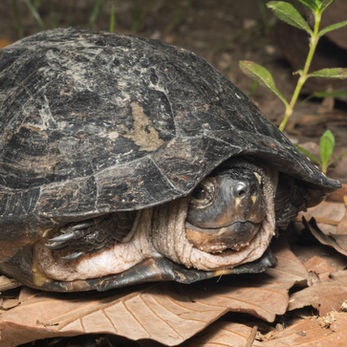
เต่าหนองน้ำดำ
Siebenrockiella crassicollis หรือที่รู้จักกันในชื่อเต่าบึงสีดำหรือเต่ายิ้ม เป็นเต่าในน้ำจืดที่มีถิ่นกำเนิดในเอเชียตะวันออกเฉียงใต้ มีลักษณะเด่นคือมีสีดำเป็นส่วนใหญ่และมีลายสีขาวถึงเหลืองบนหัว อาศัยอยู่ในแหล่งน้ำนิ่งหรือน้ำนิ่งที่มีพืชพรรณอุดมสมบูรณ์
เต่าชนิดนี้มักถูกเลี้ยงไว้เป็นสัตว์เลี้ยงหรือได้รับการเคารพบูชาในวัดพุทธ และกำลังใกล้สูญพันธุ์จากการถูกแสวงหาประโยชน์ในธุรกิจค้าสัตว์ป่าระหว่างประเทศ โดยส่วนใหญ่นำไปใช้เป็นอาหารและยาแผนโบราณในตลาดจีน
เต่าชนิดนี้มักถูกเลี้ยงไว้เป็นสัตว์เลี้ยงหรือได้รับการเคารพบูชาในวัดพุทธ และกำลังใกล้สูญพันธุ์จากการถูกแสวงหาประโยชน์ในธุรกิจค้าสัตว์ป่าระหว่างประเทศ โดยส่วนใหญ่นำไปใช้เป็นอาหารและยาแผนโบราณในตลาดจีน

งูท่อของโจดี้
Cylindrophis jodiae หรือที่เรียกกันทั่วไปว่างูท่อน้ำของโจดี้ เป็นงูในวงศ์ Cylindrophiidae พบได้ในไทย เวียดนาม และจีน โดยมีความยาวสูงสุดถึง 100 ซม.
งูท่อน้ำของโจดี้กินตัวอ่อน หนอน ปลาไหล กบ และงูขนาดเล็กเป็นหลัก ส่วนงูขนาดใหญ่และตัวเงินตัวทองเป็นเหยื่อ
งูท่อน้ำของโจดี้กินตัวอ่อน หนอน ปลาไหล กบ และงูขนาดเล็กเป็นหลัก ส่วนงูขนาดใหญ่และตัวเงินตัวทองเป็นเหยื่อ

ตุ๊กแกบ้านธรรมดา
กิ้งก่าบ้านธรรมดา (Hemidactylus frenatus) หรือที่เรียกว่ากิ้งก่าบ้านเอเชีย กิ้งก่าบ้านแปซิฟิก กิ้งก่าผนัง จิ้งจกบ้าน ติ๊กติกิ ชิปกาลี หรือกิ้งก่าพระจันทร์ มีถิ่นกำเนิดในเอเชียใต้และเอเชียตะวันออกเฉียงใต้ รวมถึงบางส่วนของโอเชียเนีย กิ้งก่าเหล่านี้หากินเวลากลางคืน โดยซ่อนตัวในเวลากลางวันและออกหากินแมลงในเวลากลางคืน มักพบตามผนังอาคารที่แสงไฟดึงดูดแมลงที่เป็นเหยื่อ โดยสามารถจดจำได้ง่ายจากเสียงร้องที่เป็นเอกลักษณ์ของมัน
กิ้งก่าบ้านธรรมดาจะมีความยาวระหว่าง 7.5–15 ซม. (3–6 นิ้ว) และมีอายุขัยประมาณ 7 ปี ไม่มีพิษและไม่เป็นอันตรายต่อมนุษย์ แม้ว่าโดยทั่วไปจะเชื่อง แต่ตัวที่ใหญ่กว่าอาจกัดได้หากเครียด ซึ่งอาจทำให้ผิวหนังแตกได้ เนื่องจากเป็นสัตว์เขตร้อน กิ้งก่าจึงเจริญเติบโตได้ดีในสภาพแวดล้อมที่อบอุ่นและชื้น และมักอาศัยอยู่ในเขตเมือง หากินบนไม้ที่เน่าเปื่อยและจับแมลง พวกมันมีความสามารถในการปรับตัวสูง โดยมักจะแข่งขันกับกิ้งก่าสายพันธุ์ที่มีความยืดหยุ่นน้อยกว่าหรือเฉื่อยชากว่าในถิ่นที่อยู่อาศัยร่วมกันด้วยการล่าแมลงและแมงมุม
กิ้งก่าบ้านธรรมดาจะมีความยาวระหว่าง 7.5–15 ซม. (3–6 นิ้ว) และมีอายุขัยประมาณ 7 ปี ไม่มีพิษและไม่เป็นอันตรายต่อมนุษย์ แม้ว่าโดยทั่วไปจะเชื่อง แต่ตัวที่ใหญ่กว่าอาจกัดได้หากเครียด ซึ่งอาจทำให้ผิวหนังแตกได้ เนื่องจากเป็นสัตว์เขตร้อน กิ้งก่าจึงเจริญเติบโตได้ดีในสภาพแวดล้อมที่อบอุ่นและชื้น และมักอาศัยอยู่ในเขตเมือง หากินบนไม้ที่เน่าเปื่อยและจับแมลง พวกมันมีความสามารถในการปรับตัวสูง โดยมักจะแข่งขันกับกิ้งก่าสายพันธุ์ที่มีความยืดหยุ่นน้อยกว่าหรือเฉื่อยชากว่าในถิ่นที่อยู่อาศัยร่วมกันด้วยการล่าแมลงและแมงมุม

งูบังเหียนของแบลนฟอร์ด
งูหางกระดิ่งของแบลนฟอร์ด (Lycodon davisonii) เป็นงูหางกระดิ่งขนาดเล็กที่ไม่มีอันตราย มีถิ่นกำเนิดในเอเชีย ตั้งชื่อตามลำตัวที่เพรียวบางคล้ายบังเหียนม้า พบได้ในกัมพูชา จีนตอนใต้ ลาว เมียนมาร์ ไทย และเวียดนาม อาศัยอยู่ในป่าที่ระดับความสูงถึง 1,500 เมตร
งูชนิดนี้เป็นสัตว์ที่อาศัยอยู่บนบก กึ่งอาศัยบนต้นไม้ และหากินเวลากลางคืน โดยกินกิ้งก่าและสัตว์มีกระดูกสันหลังขนาดเล็กชนิดอื่นๆ เป็นอาหาร
งูชนิดนี้เป็นสัตว์ที่อาศัยอยู่บนบก กึ่งอาศัยบนต้นไม้ และหากินเวลากลางคืน โดยกินกิ้งก่าและสัตว์มีกระดูกสันหลังขนาดเล็กชนิดอื่นๆ เป็นอาหาร

จิ้งเหลนหางยาว
Eutropis longicaudata หรือที่เรียกกันทั่วไปว่า long tail mabuya หรือ long-tailed sun skink เป็นกิ้งก่ารูปร่างเพรียวบางที่มีหางยาว พบได้ในภาคใต้ของจีน ฮ่องกง ไต้หวัน ลาว เวียดนาม ไทย กัมพูชา และคาบสมุทรมาเลย์
โดยทั่วไปมีสีน้ำตาลและมีแถบสีเข้มทั้งสองข้าง โดยวัดจากจมูกถึงลำตัวได้ประมาณ 14 ซม. และยาวได้ถึง 50 ซม. รวมหาง กิ้งก่าชนิดนี้อาศัยอยู่ในป่าเปิดหรือพุ่มไม้ แต่สามารถปรับตัวให้เข้ากับสภาพแวดล้อมของมนุษย์ได้ เช่น ที่ดินว่างเปล่า มักพบเหนือพื้นดินในต้นไม้ พุ่มไม้ และกำแพง โดยกินแมลง ไส้เดือน และบางครั้งกินวัสดุจากพืช สัตว์นักล่าได้แก่ งูขนาดใหญ่และนกล่าเหยื่อบางชนิด
โดยทั่วไปมีสีน้ำตาลและมีแถบสีเข้มทั้งสองข้าง โดยวัดจากจมูกถึงลำตัวได้ประมาณ 14 ซม. และยาวได้ถึง 50 ซม. รวมหาง กิ้งก่าชนิดนี้อาศัยอยู่ในป่าเปิดหรือพุ่มไม้ แต่สามารถปรับตัวให้เข้ากับสภาพแวดล้อมของมนุษย์ได้ เช่น ที่ดินว่างเปล่า มักพบเหนือพื้นดินในต้นไม้ พุ่มไม้ และกำแพง โดยกินแมลง ไส้เดือน และบางครั้งกินวัสดุจากพืช สัตว์นักล่าได้แก่ งูขนาดใหญ่และนกล่าเหยื่อบางชนิด

งูพิษตาโต
งูพิษ Trimeresurus macrops หรือที่รู้จักกันในชื่องูพิษปากกว้าง เป็นงูพิษชนิดหนึ่งที่มีถิ่นกำเนิดในเอเชียตะวันออกเฉียงใต้ มีลักษณะเด่นคือมีดวงตาขนาดใหญ่ โดยจะเห็นได้ชัดเมื่อโตเต็มวัย งูชนิดนี้พบได้ในภาคเหนือของกัมพูชา ลาว ไทย และเวียดนามตอนใต้ โดยอาหารหลักคือกบและกิ้งก่า แต่บางครั้งมันก็ล่าสัตว์ฟันแทะและนกตัวเล็กๆ ได้เช่นกัน โดยปกติจะรอเหยื่อในพุ่มไม้เตี้ยๆ และบนพื้นดิน นกล่าเหยื่อและงูขนาดใหญ่จะล่ามัน
การกัดของงูพิษปากกว้างอาจเป็นอันตรายได้ โดยทำให้เกิดอาการปวดอย่างรุนแรง บวม และเนื้อเยื่อตาย แม้ว่าจะเสียชีวิตได้น้อย แต่หากใครก็ตามที่ถูกงูชนิดนี้กัด ควรไปพบแพทย์ทันที
การกัดของงูพิษปากกว้างอาจเป็นอันตรายได้ โดยทำให้เกิดอาการปวดอย่างรุนแรง บวม และเนื้อเยื่อตาย แม้ว่าจะเสียชีวิตได้น้อย แต่หากใครก็ตามที่ถูกงูชนิดนี้กัด ควรไปพบแพทย์ทันที

เต่ากล่องเอเชีย
เต่ากล่องเอเชียซึ่งอยู่ในสกุล Cuora ในวงศ์ Geoemydidae พบได้ตั้งแต่จีนไปจนถึงอินโดนีเซีย รวมถึงฟิลิปปินส์และเอเชียตะวันออกเฉียงใต้แผ่นดินใหญ่
พวกมันอาศัยอยู่ในสภาพแวดล้อมบนบก กึ่งน้ำ หรือส่วนใหญ่อยู่ในน้ำ มักอยู่ใกล้หนองน้ำตื้นหรือลำธารที่มีพืชพรรณหนาแน่น แม้ว่าส่วนใหญ่จะกินทั้งพืชและสัตว์ แต่บางชนิดก็กินเนื้อ น่าเสียดายที่พวกมันถูกค้าขายกันมาก
พวกมันอาศัยอยู่ในสภาพแวดล้อมบนบก กึ่งน้ำ หรือส่วนใหญ่อยู่ในน้ำ มักอยู่ใกล้หนองน้ำตื้นหรือลำธารที่มีพืชพรรณหนาแน่น แม้ว่าส่วนใหญ่จะกินทั้งพืชและสัตว์ แต่บางชนิดก็กินเนื้อ น่าเสียดายที่พวกมันถูกค้าขายกันมาก

ตุ๊กแกโตไก
กิ้งก่าโตเคย์ (Gekko gecko) เป็นกิ้งก่าที่หากินเวลากลางคืน มีถิ่นกำเนิดในเอเชียและหมู่เกาะแปซิฟิกบางแห่ง รวมถึงพื้นที่ตั้งแต่ภาคตะวันออกเฉียงเหนือของอินเดียไปจนถึงนิวกินีตะวันตก
กิ้งก่าชนิดนี้อาศัยอยู่ในป่าฝน แต่ปรับตัวได้ดีในที่อยู่อาศัยของมนุษย์ในชนบท โดยจะล่าแมลงตามผนังและเพดานในตอนกลางคืน ด้วยความยาวเฉลี่ย 25–30 ซม. (40 ซม. ในบางกรณี) กิ้งก่าชนิดนี้จัดอยู่ในกลุ่มกิ้งก่าที่ใหญ่ที่สุด
กิ้งก่าชนิดนี้ขึ้นชื่อในเรื่องความก้าวร้าวและพฤติกรรมแย่งอาณาเขต จึงสามารถกัดได้อย่างแรง
กิ้งก่าชนิดนี้อาศัยอยู่ในป่าฝน แต่ปรับตัวได้ดีในที่อยู่อาศัยของมนุษย์ในชนบท โดยจะล่าแมลงตามผนังและเพดานในตอนกลางคืน ด้วยความยาวเฉลี่ย 25–30 ซม. (40 ซม. ในบางกรณี) กิ้งก่าชนิดนี้จัดอยู่ในกลุ่มกิ้งก่าที่ใหญ่ที่สุด
กิ้งก่าชนิดนี้ขึ้นชื่อในเรื่องความก้าวร้าวและพฤติกรรมแย่งอาณาเขต จึงสามารถกัดได้อย่างแรง

งูแส้จมูกยาวอินโดจีน
งูแส้ดำ Ahaetulla fusca เป็นงูชนิดหนึ่งในวงศ์ Colubridae พบในประเทศไทย กัมพูชา เวียดนาม และเมียนมาร์
งูชนิดนี้มีพิษแต่มีเขี้ยวหลังและไม่ดุร้าย พบได้ง่ายที่สุดในเวลากลางคืน มักนอนอยู่บนพุ่มไม้และต้นไม้ โดยอาศัยการพรางตัวอันยอดเยี่ยมเพื่อปกป้องตัว
งูชนิดนี้มีพิษแต่มีเขี้ยวหลังและไม่ดุร้าย พบได้ง่ายที่สุดในเวลากลางคืน มักนอนอยู่บนพุ่มไม้และต้นไม้ โดยอาศัยการพรางตัวอันยอดเยี่ยมเพื่อปกป้องตัว

งูน้ำของแจ็ค
งูน้ำแจ็ค (Homalopsis mereljcoxi) เป็นงูน้ำขนาดใหญ่ที่มีความยาวได้ถึง 137 ซม. สามารถจำแนกได้จากหัวสีน้ำตาลกว้าง มีแถบสีเข้มที่ตาและลวดลายที่โดดเด่น ลำตัวแบนแข็งแรง มีแถบสีน้ำตาลและสีอ่อนสลับกัน
พบได้ในแหล่งน้ำที่ราบลุ่มต่างๆ เช่น แม่น้ำ ทะเลสาบ และหนองบึง โดยจะซ่อนตัวอยู่ในโพรงในเวลากลางวัน โดยกินปลาเป็นหลัก นอกจากนี้ยังอาจกินสัตว์จำพวกกุ้งและกบด้วย
พบได้ในแหล่งน้ำที่ราบลุ่มต่างๆ เช่น แม่น้ำ ทะเลสาบ และหนองบึง โดยจะซ่อนตัวอยู่ในโพรงในเวลากลางวัน โดยกินปลาเป็นหลัก นอกจากนี้ยังอาจกินสัตว์จำพวกกุ้งและกบด้วย

เต่าหูแดง
เต่าหูแดง (Trachemys scripta elegans) เป็นเต่าทะเลกึ่งน้ำที่อยู่ในวงศ์ Emydidae ซึ่งเป็นชนิดย่อยของเต่าบก (Trachemys scripta)
เต่าชนิดนี้ได้รับความนิยมอย่างมากในการเลี้ยงเป็นสัตว์เลี้ยง โดยเฉพาะอย่างยิ่งในสหรัฐอเมริกา ซึ่งเป็นเต่าที่เลี้ยงกันมากที่สุด อย่างไรก็ตาม ความนิยมดังกล่าวทำให้เต่าชนิดนี้ถูกปล่อยสู่ธรรมชาติอย่างกว้างขวาง ส่งผลให้ประชากรที่รุกรานเกินขอบเขตถิ่นกำเนิดของมัน ส่งผลให้เต่าชนิดนี้ถูกจัดให้เป็น 1 ใน 100 สายพันธุ์ที่รุกรานมากที่สุดในโลก
เต่าชนิดนี้ได้รับความนิยมอย่างมากในการเลี้ยงเป็นสัตว์เลี้ยง โดยเฉพาะอย่างยิ่งในสหรัฐอเมริกา ซึ่งเป็นเต่าที่เลี้ยงกันมากที่สุด อย่างไรก็ตาม ความนิยมดังกล่าวทำให้เต่าชนิดนี้ถูกปล่อยสู่ธรรมชาติอย่างกว้างขวาง ส่งผลให้ประชากรที่รุกรานเกินขอบเขตถิ่นกำเนิดของมัน ส่งผลให้เต่าชนิดนี้ถูกจัดให้เป็น 1 ใน 100 สายพันธุ์ที่รุกรานมากที่สุดในโลก

งูคุกรีแถบเล็ก
Oligodon fasciolatus หรือที่รู้จักกันในชื่องูคุ๊กรีแถบเล็กหรืองูคุ๊กรีฟาสซิโอเลต เป็นงูชนิดหนึ่งในวงศ์ Colubridae มีถิ่นกำเนิดในเอเชียตะวันออกเฉียงใต้
คำว่า "คุ๊กรี" หมายถึงความคมของฟัน งูชนิดนี้มีพฤติกรรมการชำแหละคางคกพิษที่มีชีวิต (Duttaphrynus melanostictus) เพื่อหลีกเลี่ยงสารคัดหลั่งที่เป็นพิษจากคางคก O. fasciolatus พบได้ในภาคตะวันออกเฉียงใต้ของเมียนมาร์ ไทย กัมพูชา ลาว และเวียดนาม โดยส่วนใหญ่อาศัยอยู่ในพื้นที่ป่า งูชนิดนี้สามารถโตได้ยาวถึง 115 ซม.
คำว่า "คุ๊กรี" หมายถึงความคมของฟัน งูชนิดนี้มีพฤติกรรมการชำแหละคางคกพิษที่มีชีวิต (Duttaphrynus melanostictus) เพื่อหลีกเลี่ยงสารคัดหลั่งที่เป็นพิษจากคางคก O. fasciolatus พบได้ในภาคตะวันออกเฉียงใต้ของเมียนมาร์ ไทย กัมพูชา ลาว และเวียดนาม โดยส่วนใหญ่อาศัยอยู่ในพื้นที่ป่า งูชนิดนี้สามารถโตได้ยาวถึง 115 ซม.

ตุ๊กแกบ้านหางแบน
กิ้งก่าหางแบน (Hemidactylus platyurus) หรือที่รู้จักกันในชื่อกิ้งก่าหางยาวหรือกิ้งก่าบ้านเอเชีย เป็นสายพันธุ์ที่มีถิ่นกำเนิดในเอเชียตะวันออกเฉียงใต้และเอเชียใต้
มักพบในสัตว์เลี้ยง โดยสังเกตได้จากแผ่นหนังที่พับอยู่ด้านข้างคล้ายกับกิ้งก่าบินขนาดเล็ก
มักพบในสัตว์เลี้ยง โดยสังเกตได้จากแผ่นหนังที่พับอยู่ด้านข้างคล้ายกับกิ้งก่าบินขนาดเล็ก

เต่าวัดหัวเหลือง
เต่าวัดหัวเหลือง (Heosemys annandalii) เป็นสัตว์ใกล้สูญพันธุ์ขนาดใหญ่ที่มีถิ่นกำเนิดในเอเชียตะวันออกเฉียงใต้ โดยมีรายงานว่าชื่อสามัญของเต่าชนิดนี้มาจากการที่เต่าชนิดนี้มักพบบริเวณใกล้วัดในพุทธศาสนา
เต่าชนิดนี้สามารถโตได้ถึง 51 ซม. เมื่อโตเต็มวัย โดยเต่าชนิดนี้เป็นสัตว์ที่กินพืชและสัตว์น้ำเป็นส่วนใหญ่ การค้าเต่าชนิดนี้ถูกระงับโดยอนุสัญญาว่าด้วยการค้าระหว่างประเทศซึ่งชนิดสัตว์ป่าและพืชป่าที่ใกล้สูญพันธุ์ (CITES) ในเดือนกรกฎาคม 2555
เต่าชนิดนี้สามารถโตได้ถึง 51 ซม. เมื่อโตเต็มวัย โดยเต่าชนิดนี้เป็นสัตว์ที่กินพืชและสัตว์น้ำเป็นส่วนใหญ่ การค้าเต่าชนิดนี้ถูกระงับโดยอนุสัญญาว่าด้วยการค้าระหว่างประเทศซึ่งชนิดสัตว์ป่าและพืชป่าที่ใกล้สูญพันธุ์ (CITES) ในเดือนกรกฎาคม 2555

งูพิษปากขาว
Trimeresurus albolabris หรือที่รู้จักกันในชื่องูพิษปากขาวหรืองูพิษต้นไม้ปากขาว เป็นงูพิษที่มีถิ่นกำเนิดในเอเชียตะวันออกเฉียงใต้ พบได้น้อยกว่างูพิษปากขาวตาโตในบางกะเจ้ามาก
งูพิษชนิดนี้ล่าเหยื่อเป็นนก กบตัวเล็ก และสัตว์เลี้ยงลูกด้วยนมขนาดเล็ก โดยจับเหยื่อไว้จนกว่าจะตาย แทนที่จะโจมตีแล้วปล่อย พิษของงูชนิดนี้มีพิษต่อเลือดเป็นส่วนใหญ่ แม้ว่าการถูกกัดอาจทำให้เกิดพิษเล็กน้อยหรือร้ายแรง แต่การเสียชีวิตเกิดขึ้นได้น้อยมาก
งูพิษชนิดนี้ล่าเหยื่อเป็นนก กบตัวเล็ก และสัตว์เลี้ยงลูกด้วยนมขนาดเล็ก โดยจับเหยื่อไว้จนกว่าจะตาย แทนที่จะโจมตีแล้วปล่อย พิษของงูชนิดนี้มีพิษต่อเลือดเป็นส่วนใหญ่ แม้ว่าการถูกกัดอาจทำให้เกิดพิษเล็กน้อยหรือร้ายแรง แต่การเสียชีวิตเกิดขึ้นได้น้อยมาก

กิ้งก่าพระอาทิตย์ธรรมดา
Eutropis multifasciata หรือที่เรียกอีกอย่างว่า East Indian brown mabuya หรือ Common Sun Skink เป็นสปีชีส์กิ้งก่า
หางมีความยาว 1.3 ถึง 1.6 เท่าของความยาวหัวและลำตัว โดยทั่วไปจะมีสีน้ำตาลหรือมะกอก บางตัวอาจมีสีสม่ำเสมอหรือมีจุดสีขาวหรือแดงขนาดใหญ่ที่ด้านข้างลำตัวทั้งสองข้าง
หางมีความยาว 1.3 ถึง 1.6 เท่าของความยาวหัวและลำตัว โดยทั่วไปจะมีสีน้ำตาลหรือมะกอก บางตัวอาจมีสีสม่ำเสมอหรือมีจุดสีขาวหรือแดงขนาดใหญ่ที่ด้านข้างลำตัวทั้งสองข้าง

กิ้งก่าสยามนิ่ม
กิ้งก่าสยาม (Lygosoma siamensis) เป็นกิ้งก่าสายพันธุ์หนึ่งที่มีถิ่นกำเนิดในกัมพูชา ลาว มาเลเซีย ไทย และเวียดนาม ตามธรรมชาติแล้วกิ้งก่าชนิดนี้จะอาศัยอยู่ในป่า แต่ก็ได้ปรับตัวให้เข้ากับพื้นที่เกษตรกรรม สวนสาธารณะในเมือง และพื้นที่ว่างเปล่าด้วย โดยทั่วไปแล้ว กิ้งก่าชนิดนี้จะพบอยู่ใต้ท่อนไม้ที่ผุพัง หรือในใบไม้ที่เปียกชื้นและในดิน
ขาเล็กๆ ของมันช่วยให้เคลื่อนตัวผ่านดินและพืชที่เน่าเปื่อยได้สะดวก กิ้งก่าชนิดนี้จะพับขาแนบกับลำตัวเพื่อหลบเลี่ยงศัตรูและเคลื่อนไหวเหมือนงู
ขาเล็กๆ ของมันช่วยให้เคลื่อนตัวผ่านดินและพืชที่เน่าเปื่อยได้สะดวก กิ้งก่าชนิดนี้จะพับขาแนบกับลำตัวเพื่อหลบเลี่ยงศัตรูและเคลื่อนไหวเหมือนงู

ตุ๊กแกสี่เล็บธรรมดา
Gehyra mutilata หรือที่รู้จักกันในชื่อ กิ้งก่าสี่กรงเล็บทั่วไป กิ้งก่าแปซิฟิก กิ้งก่าตอขา หรือกิ้งก่าน้ำตาลในอินโดนีเซีย เป็นสายพันธุ์หนึ่งในวงศ์ Gekkonidae กิ้งก่าชนิดนี้มีถิ่นกำเนิดในเอเชียตะวันออกเฉียงใต้ แต่ได้แพร่พันธุ์ไปยังภูมิภาคต่างๆ เช่น ศรีลังกา อินโดจีน และเกาะต่างๆ ในมหาสมุทรแปซิฟิก โดยทั่วไปแล้ว G. mutilata จะมีรูปร่างอ้วนท้วนกว่ากิ้งก่าบ้าน (Hemidactylus frenatus) ที่พบเห็นได้ทั่วไป โดยมีผิวหนังนุ่มและบอบบาง สีของกิ้งก่ามักจะเป็นสีม่วงอ่อนหรือสีเทาอมชมพู และกิ้งก่าที่อายุน้อยกว่าจะมีจุดสีทอง ซึ่งจะค่อยๆ จางลงเมื่อโตเต็มวัย
Amphibians
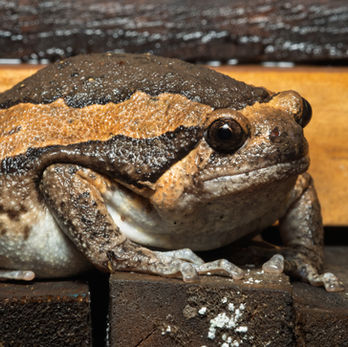
กบกระดองลาย
กบลาย (Kaloula pulchra) หรือที่รู้จักกันในชื่อกบสีเอเชียหรือกบอ้วน เป็นสัตว์สะเทินน้ำสะเทินบกที่มีลำตัวอ้วนกลม มีถิ่นกำเนิดในเอเชียตะวันออกเฉียงใต้ มีความยาวตั้งแต่ 5.4 ถึง 7.5 ซม. มีสีน้ำตาลเข้มและมีลายทางสีชมพูแซลมอนหรือสีน้ำตาลทองแดง ปรับตัวเข้ากับสภาพแวดล้อมต่างๆ ได้ อาศัยอยู่ในป่าที่ราบลุ่ม พื้นที่ในเมือง และภูมิประเทศชนบท ในช่วงฤดูแล้ง มันจะขุดรูใต้ดิน โผล่ขึ้นมาหลังฝนตกเพื่อผสมพันธุ์และหาอาหาร โดยส่วนใหญ่จะเป็นมดและปลวก เมื่อถูกคุกคาม มันจะพองตัวและขับสารที่มีกลิ่นเหม็นออกมาเพื่อป้องกันตัว เนื่องจากกบลายนี้ได้รับความนิยมในธุรกิจสัตว์เลี้ยง จึงทำให้มีการนำกบลายนี้ไปยังภูมิภาคที่ไม่ใช่ถิ่นกำเนิดหลายแห่ง ทำให้เกิดความกังวลเกี่ยวกับศักยภาพในการเป็นสัตว์รุกราน
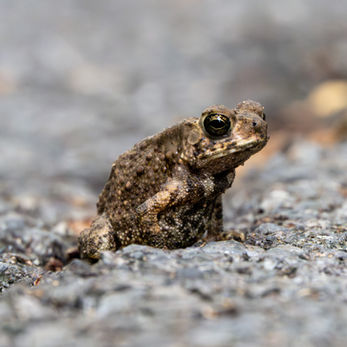
คางคกเอเชีย
Duttaphrynus melanostictus หรือที่รู้จักกันในชื่อ คางคกเอเชีย คางคกหนามดำเอเชีย หรือ คางคกชวา เป็นสายพันธุ์ที่พบได้ทั่วไปในเอเชียใต้และเอเชียตะวันออกเฉียงใต้ โดยทั่วไปจะมีความยาวประมาณ 20 ซม. (8 นิ้ว) ผสมพันธุ์ในช่วงมรสุม โดยมีลูกอ๊อดสีดำออกมา
มักพบเห็นคางคกจำนวนมากหลังฝนตกหนัก และเคลื่อนไหวในเวลากลางคืน โดยเฉพาะบริเวณเสาไฟข้างถนนในช่วงที่ปลวกชุกชุม คางคกกินสัตว์ไม่มีกระดูกสันหลังหลายชนิด รวมทั้งแมงป่องด้วย
มักพบเห็นคางคกจำนวนมากหลังฝนตกหนัก และเคลื่อนไหวในเวลากลางคืน โดยเฉพาะบริเวณเสาไฟข้างถนนในช่วงที่ปลวกชุกชุม คางคกกินสัตว์ไม่มีกระดูกสันหลังหลายชนิด รวมทั้งแมงป่องด้วย
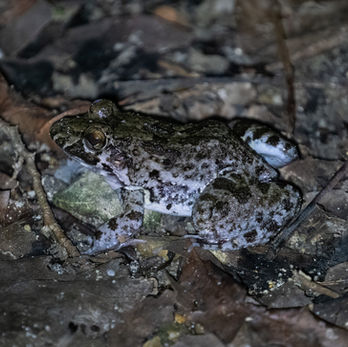
กบโกงกาง
Fejervarya moodiei เป็นสายพันธุ์กบในวงศ์ Dicroglossidae มักสับสนกับ Fejervarya cancrivora โดยมีถิ่นกำเนิดในฟิลิปปินส์ (โดยเฉพาะมะนิลา ลูซอน) ไทย เกาะไหหลำ (จีน) และอินเดีย
อาศัยอยู่ในหนองน้ำจืดและหนองน้ำจืดสลับกัน
อาศัยอยู่ในหนองน้ำจืดและหนองน้ำจืดสลับกัน
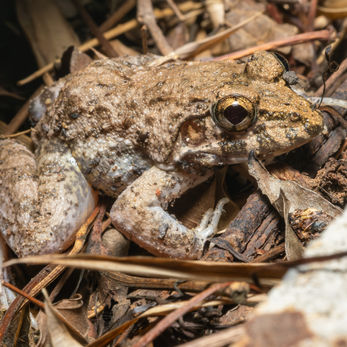
กบทุ่งนา
Fejervarya limnocharis เป็นสายพันธุ์กบที่พบในเอเชียตะวันออกเฉียงใต้และบางส่วนของอินโดจีน รู้จักกันทั่วไปในชื่อ Boie's wart frog, rice field frog และ Asian grass frog โดยทั่วไปจะมีสีเทาน้ำตาลหรือสีเขียวมะกอกด้านบน บางครั้งอาจมีสีแดงสดปนอยู่ด้วย มีรอยดำเป็นรูปตัววีระหว่างดวงตา แถบกระดูกสันหลังสีเหลือง (โดยปกติจะมี) ริมฝีปากและขามีแถบ และช่องท้องสีขาว คอของตัวผู้มีจุดสีน้ำตาล
กบชนิดนี้มักขายเป็นอาหารในประเทศเอเชียตะวันออกเฉียงใต้ เช่น ไทย ลาว และกัมพูชา
กบชนิดนี้มักขายเป็นอาหารในประเทศเอเชียตะวันออกเฉียงใต้ เช่น ไทย ลาว และกัมพูชา
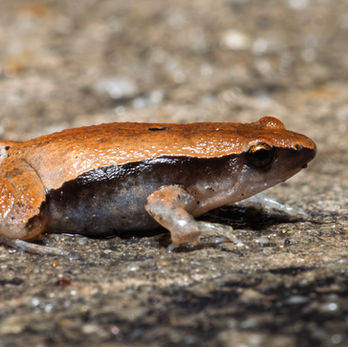
กบคอรัสด้านมืด
Microhyla heymonsi หรือที่รู้จักกันในชื่อกบคอรัสด้านมืดหรือกบข้าวไต้หวัน เป็นกบสายพันธุ์เล็กที่พบในภาคตะวันออกเฉียงเหนือของอินเดีย จีนตอนใต้ ไต้หวัน และเอเชียตะวันออกเฉียงใต้ ขยายพันธุ์ไปทางใต้จนถึงคาบสมุทรมาเลย์ สุมาตรา และหมู่เกาะนิโคบาร์ใหญ่
เดิมทีมีการบรรยายลักษณะจากไต้หวัน โดยทั่วไปมีความยาวระหว่างปากถึงช่องอก 16–26 มม. สีหลังเป็นสีชมพูหรือสีเทา มีแถบสีดำด้านข้างตั้งแต่ปลายปากถึงขาหนีบ กบชนิดนี้อาศัยอยู่ในบริเวณที่ถูกรบกวนและพืชรอง โดยเพาะพันธุ์ในแหล่งน้ำต่างๆ เช่น แอ่งน้ำฝน ทุ่งนา คูน้ำ หนองบึง และลำธารที่ไหลช้า
เดิมทีมีการบรรยายลักษณะจากไต้หวัน โดยทั่วไปมีความยาวระหว่างปากถึงช่องอก 16–26 มม. สีหลังเป็นสีชมพูหรือสีเทา มีแถบสีดำด้านข้างตั้งแต่ปลายปากถึงขาหนีบ กบชนิดนี้อาศัยอยู่ในบริเวณที่ถูกรบกวนและพืชรอง โดยเพาะพันธุ์ในแหล่งน้ำต่างๆ เช่น แอ่งน้ำฝน ทุ่งนา คูน้ำ หนองบึง และลำธารที่ไหลช้า

กบเขียวธรรมดา
กบเขียว (Hylarana erythraea) เป็นสายพันธุ์หนึ่งในวงศ์กบแท้ Ranidae หรือที่รู้จักกันในชื่อกบข้าวเขียว กบหูแดง หรือกบใบไม้
โดยทั่วไปตัวผู้จะมีความยาว 30–45 มม. ในขณะที่ตัวเมียจะมีความยาวได้ถึง 50–75 มม. ลูกอ๊อดสามารถยาวได้ถึง 36 มม. มีผิวเรียบสีเขียวสดใส พบได้ในเอเชียตะวันออกเฉียงใต้ รวมทั้งบรูไน กัมพูชา อินโดนีเซีย ลาว มาเลเซีย เมียนมาร์ สิงคโปร์ ไทย และเวียดนาม อาศัยอยู่ในสภาพแวดล้อมต่างๆ ตั้งแต่ป่าที่ราบลุ่มไปจนถึงหนองน้ำจืด โดยสามารถพบเห็นได้สูงถึง 1,200 เมตรเหนือระดับน้ำทะเล
โดยทั่วไปตัวผู้จะมีความยาว 30–45 มม. ในขณะที่ตัวเมียจะมีความยาวได้ถึง 50–75 มม. ลูกอ๊อดสามารถยาวได้ถึง 36 มม. มีผิวเรียบสีเขียวสดใส พบได้ในเอเชียตะวันออกเฉียงใต้ รวมทั้งบรูไน กัมพูชา อินโดนีเซีย ลาว มาเลเซีย เมียนมาร์ สิงคโปร์ ไทย และเวียดนาม อาศัยอยู่ในสภาพแวดล้อมต่างๆ ตั้งแต่ป่าที่ราบลุ่มไปจนถึงหนองน้ำจืด โดยสามารถพบเห็นได้สูงถึง 1,200 เมตรเหนือระดับน้ำทะเล
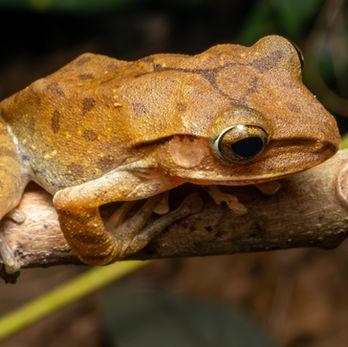
กบต้นไม้ขาจุด
กบต้นไม้ขาจุดหรือกบขาลายฮ่องกง เป็นสัตว์ในวงศ์กบพุ่มไม้ (Rhacophoridae) สายพันธุ์นี้มีถิ่นกำเนิดในจีนตอนกลาง ใต้ และตะวันตกเฉียงใต้ (รวมถึงฮ่องกงและไหหลำ) และคาบสมุทรอินโดจีน สายพันธุ์นี้จัดอยู่ในกลุ่มสัตว์ที่มีความเสี่ยงต่ำเนื่องจากมีการกระจายพันธุ์กว้างขวาง ปรับตัวเข้ากับแหล่งที่อยู่อาศัยต่างๆ ได้ และคาดว่ามีจำนวนมากมาย
bottom of page

